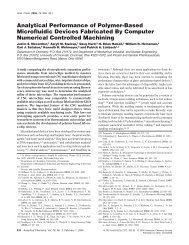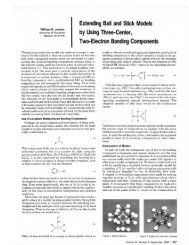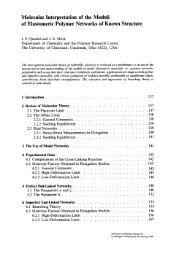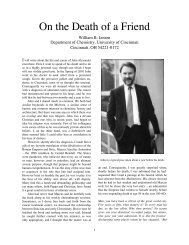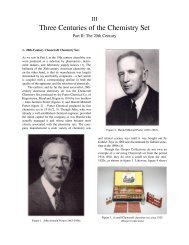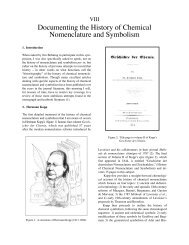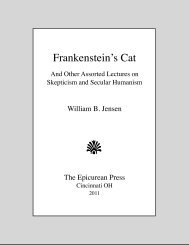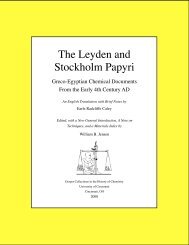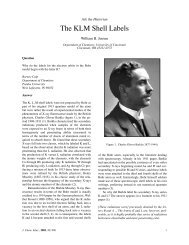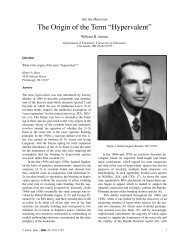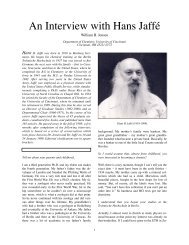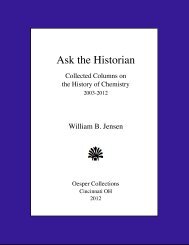Chemical Caricatures.pdf - University of Cincinnati
Chemical Caricatures.pdf - University of Cincinnati
Chemical Caricatures.pdf - University of Cincinnati
Create successful ePaper yourself
Turn your PDF publications into a flip-book with our unique Google optimized e-Paper software.
CHYMISTS:<br />
THAT STRANGE CLASS OF<br />
MORTALS<br />
<strong>Caricatures</strong> <strong>of</strong> Famous Chemists with a Few<br />
Physicists and Biologists Added<br />
BY<br />
WILLIAM B. JENSEN<br />
Oesper Collections<br />
<strong>Cincinnati</strong><br />
2010
CHYMISTS:<br />
THAT STRANGE CLASS OF<br />
MORTALS<br />
<strong>Caricatures</strong> <strong>of</strong> Famous Chemists with a Few<br />
Physicists and Biologists Added<br />
BY<br />
WILLIAM B. JENSEN<br />
Oesper Collections<br />
<strong>Cincinnati</strong><br />
2010
“The chymists are a strange class <strong>of</strong> mortals, impelled by<br />
an almost insane impulse to seek their pleasures amid<br />
smoke and vapor, soot and flame, poisons and<br />
poverty. Yet among all these evils I seem to<br />
live so sweetly that may I die if I were to<br />
changes places with the Persian King.”<br />
Johann Joachim Becher<br />
Physica Subterranea, 1667
INTRODUCTION<br />
The majority <strong>of</strong> the following caricatures were done more<br />
than 40 years ago when I was a junior at the <strong>University</strong> <strong>of</strong><br />
Wisconsin-Madison and attending Aaron Ihde’s lectures on<br />
the history <strong>of</strong> chemistry. Each week, rather than taking lecture<br />
notes, I would instead select one <strong>of</strong> the chemists that Ihde was<br />
lecturing on and do a caricature based on the portraits found<br />
in Ihde’s textbook, The Development <strong>of</strong> Modern Chemistry<br />
(1964). This original set has since been supplemented by<br />
about another half-dozen caricatures prompted by requests<br />
over the years from various individuals and journals. In the<br />
1970s there was little interest in these drawings, but with<br />
the passage <strong>of</strong> time, a sort <strong>of</strong> underground demand for them<br />
has spontaneously arisen among teachers and students <strong>of</strong><br />
chemistry and many have since been reproduced on c<strong>of</strong>fee<br />
mugs, T-shirts, and on various internet sites. More recently I<br />
was informed that one <strong>of</strong> them (Robert Bunsen) was even<br />
being used as the logo for a rock band. In any case, I thought<br />
it was about time to collect and present them in a more<br />
permanent and convenient format by supplementing each<br />
drawing with a short biographical sketch <strong>of</strong> the subject in<br />
question, as well as with an occasional hint concerning the<br />
symbolism used.<br />
! Also included as an appendix is a short piece <strong>of</strong><br />
chemical doggerel which I first published in 1972 under the<br />
title <strong>of</strong> “A Chemist’s Annotated Mother Goose <strong>of</strong> <strong>Chemical</strong><br />
Bonding Theory,” in which I coupled variants <strong>of</strong> well-known<br />
nursery rhymes with caricatures <strong>of</strong> noted physicists and chemists<br />
connected in some fashion with the history <strong>of</strong> chemical<br />
bonding. Two <strong>of</strong> these (Langmuir and Pauling) already appear<br />
among the individual caricatures, but since these, unlike the<br />
nursery rhymes, also come with short biographical sketches, I<br />
hope readers are willing to forgive the redundancy.<br />
- 1 -<br />
William B. Jensen<br />
April 2010
WILLIAM B. JENSEN<br />
I<br />
SCEPTICAL CHYMIST<br />
Robert Boyle (1627-1691). Irish chemist and<br />
natural philosopher. As a son <strong>of</strong> the Earl <strong>of</strong> Cork,<br />
Boyle was independently wealthy and so was able to<br />
live the life <strong>of</strong> a private scientific “virtuoso.” Best<br />
known for his advocacy <strong>of</strong> a mechanical corpuscular<br />
or particulate approach to physics and chemistry, as<br />
opposed to the older hylomorphic doctrines <strong>of</strong><br />
Aristotle and Paracelsus, Boyle authored numerous<br />
books, <strong>of</strong> which his most famous was perhaps The<br />
Sceptical Chymist, first published in 1661. He is<br />
known to students <strong>of</strong> introductory chemistry today<br />
largely through his discovery <strong>of</strong> Boyle’s law (1662),<br />
which states that the volume <strong>of</strong> a gas varies inversely<br />
with applied pressure at constant temperature.<br />
- 2 -
CHYMISTS<br />
THAT STRANGE CLASS OF MORTALS<br />
SCEPTICAL CHYMIST<br />
- 3 -
WILLIAM B. JENSEN<br />
II<br />
AIRS<br />
Joseph Priestley (1733-1804). English chemist and<br />
unitarian minister. Priestley earned his living as a<br />
minister and as a teacher at various dissenting<br />
academies. His work in chemistry was done in his<br />
spare time and largely during the period when he<br />
served as private librarian to Lord Shelburne. It<br />
dealt almost exclusively with the use <strong>of</strong> the pneumatic<br />
trough to discover a large number <strong>of</strong> new “airs”<br />
or gases, including nitrogen oxide, nitrogen dioxide,<br />
dinitrogen oxide, ammonia, hydrogen chloride, sulfur<br />
dioxide and, most famously <strong>of</strong> all, dioxygen (1774), all<br />
<strong>of</strong> which were described in the various editions <strong>of</strong> his<br />
multi-volume work Experiments and Observations<br />
on Different Kinds <strong>of</strong> Air.<br />
He also investigated the processes <strong>of</strong> brewing,<br />
photosynthesis, and respiration, and invented soda<br />
water. Priestley was a prolific writer, not only on<br />
chemistry, but also on the subjects <strong>of</strong> theology, history,<br />
geography, natural philosophy, and electricity. Due to<br />
his liberal political and religious opinions, his home<br />
and laboratory were destroyed by a Birmingham mob<br />
in 1791, and he spent his final years in the small<br />
village <strong>of</strong> Northumberland, Pennsylvania, where he wrote<br />
several pamphlets defending the outdated phlogiston<br />
theory against Lavoisier’s newer oxygen theory <strong>of</strong><br />
combustion.<br />
- 4 -
CHYMISTS<br />
THAT STRANGE CLASS OF MORTALS<br />
AIRS<br />
- 5 -
WILLIAM B. JENSEN<br />
III<br />
ATOMIC MARBLES<br />
John Dalton (1766-1844). English chemist and<br />
natural philosopher. A self-educated Quaker, Dalton<br />
was born in the village <strong>of</strong> Eaglesfield in northwest<br />
England and worked as a school teacher much <strong>of</strong> his<br />
life. Originally interested in meteorology, he kept<br />
detailed records <strong>of</strong> the local weather for many<br />
decades. This resulted in his first book, Meteorological<br />
Observations and Essays (1793) and eventually led to<br />
an interest in the chemistry and physics <strong>of</strong> mixed<br />
gases, to the discovery <strong>of</strong> his famous law <strong>of</strong> partial<br />
pressures, and ultimately to his chemical atomic theory.<br />
Whereas 17th-century corpuscularism had focused<br />
on atomic shape and the 18th-century dynamic atomism<br />
<strong>of</strong> Newton on interatomic forces as the keys to<br />
chemical behavior, Dalton focused instead on atomic<br />
weight. In 1805 he published his first table <strong>of</strong> atomic<br />
weights and in 1808 he summarized his new<br />
atomistic approach to chemistry in the first volume <strong>of</strong><br />
his book, A New System <strong>of</strong> <strong>Chemical</strong> Philosophy.<br />
Unfortunately Dalton’s procedures for extracting<br />
atomic weights from gravimetric composition, via his<br />
so-called rules <strong>of</strong> simplicity, were flawed and<br />
virtually all <strong>of</strong> his reported atomic weights are now<br />
known to be incorrect. The result was almost 50 years<br />
<strong>of</strong> confusion in which chemists used a variety <strong>of</strong><br />
competing atomic and equivalent weight scales. Not<br />
until the publication <strong>of</strong> Cannizzaro’s work in 1858<br />
was this problem finally resolved. Dalton is also<br />
known for having given (1794) the first accurate<br />
description <strong>of</strong> color blindness or “Daltonism.”<br />
- 6 -
CHYMISTS<br />
THAT STRANGE CLASS OF MORTALS<br />
ATOMIC MARBLES<br />
- 7 -
WILLIAM B. JENSEN<br />
IV<br />
EQUAL VOLUMES<br />
Amedeo Avogadro (1776-1856). Italian physicist.<br />
Initially a law student, Avogadro did not begin the<br />
study <strong>of</strong> physics until 1800, eventually becoming<br />
Pr<strong>of</strong>essor <strong>of</strong> Physics at the Royal College at Vercelli<br />
(1809) and then at the <strong>University</strong> <strong>of</strong> Turin (1820,1834).<br />
He is best known for his essay <strong>of</strong> 1811 in which he<br />
attempted to reconcile Dalton’s atomic theory with<br />
Gay-Lussac’s law <strong>of</strong> combining volumes. His solution<br />
rested on two assumptions: 1) equal volumes <strong>of</strong> gases<br />
at the same temperature and pressure contain equal<br />
numbers <strong>of</strong> molecules, and 2) the molecules <strong>of</strong> simple<br />
substances could be polyatomic. The first assumption<br />
allowed one to determine molecular weights by<br />
measuring gas densities, and the second allowed one<br />
to extract atomic weights from the molecular weights<br />
<strong>of</strong> simple substances given a knowledge <strong>of</strong> the<br />
volumetric stoichiometries <strong>of</strong> their gas-phase reactions.<br />
Unfortunately Avogardro’s second assumption was<br />
at variance with the chemical theory <strong>of</strong> the time, which<br />
assumed that all simple substances were inherently<br />
monoatomic, and his procedure for extracting atomic<br />
weights from molecular weights could only be applied<br />
to a few elements. As a consequence, his work was<br />
largely ignored during his lifetime. It was only in<br />
1858, when the second assumption was no longer in<br />
conflict with accepted theory, that Cannizzaro was<br />
able to reawaken an interest in Avogadro’s work<br />
through his discovery <strong>of</strong> a more general method for<br />
extracting atomic weights from the resulting molecular<br />
weights.<br />
- 8 -
CHYMISTS<br />
THAT STRANGE CLASS OF MORTALS<br />
EQUAL VOLUMES<br />
- 9 -
WILLIAM B. JENSEN<br />
V<br />
FOND DICTATOR<br />
Jöns Jacob Berzelius (1779-1848). Swedish chemist.<br />
Originally trained as a physician, Berzelius was<br />
largely self-taught as a chemist and spent most <strong>of</strong> his<br />
adult life as a pr<strong>of</strong>essor at the Karolinska Medical<br />
Institute in Stockholm. A superb analytical chemist,<br />
he is credited with the discovery <strong>of</strong> the elements<br />
cerium (1803), thorium (1815), and selenium (1817)<br />
and with being the first to isolate the elements silicon,<br />
titanium, and zirconium. He is also responsible for<br />
having almost single-handedly generated the first<br />
comprehensive table <strong>of</strong> accurate atomic weights<br />
(though several <strong>of</strong> his values are now known, for<br />
theoretical reasons, to be either multiples or fractions<br />
<strong>of</strong> our current values).<br />
However, Berzelius is perhaps best known for<br />
his electrochemical or dualistic theory <strong>of</strong> chemical<br />
combination, which dominated chemical theory<br />
during much <strong>of</strong> the first half <strong>of</strong> the 19th century, and<br />
for his introduction <strong>of</strong> our current chemical symbolism<br />
based on the use <strong>of</strong> letter abbreviations for<br />
each atom type and numerical subscripts to represent<br />
their combining ratios. He was also the author <strong>of</strong> an<br />
influential multi-volume textbook, monographs on<br />
blowpipe analysis and the chemical classification <strong>of</strong><br />
minerals, and <strong>of</strong> an annual review <strong>of</strong> chemical<br />
research (the Jahres-Bericht) which he published<br />
between 1822-1848. Through this latter medium he<br />
was able to “dictate” much <strong>of</strong> what happened in<br />
European chemistry and to coin much <strong>of</strong> our presentday<br />
chemical vocabulary, including such terms as<br />
halogen, isomer, polymer, catalyst, and protein.<br />
- 10 -
CHYMISTS<br />
THAT STRANGE CLASS OF MORTALS<br />
FOND DICTATOR<br />
- 11 -
WILLIAM B. JENSEN<br />
VI<br />
PHOTO<br />
Louis Jacques Mandé Daguerre (1789-1851).<br />
French artist and inventor. Born in Cormeilles near<br />
Paris, Daguerre worked as a painter <strong>of</strong> opera scenery<br />
and dioramas. These activities led to a interest in the<br />
artistic possibilities <strong>of</strong> permanently capturing optical<br />
images on chemically-sensitized surfaces. Starting in<br />
1826 he collaborated with Joseph Nicéphore Niepce<br />
on various attempts to develop a practical photographic<br />
system and, after the death <strong>of</strong> Niepce in<br />
1833, continued these efforts on his own. By 1839 he<br />
had achieved success and formally presented his<br />
process to the French Academy <strong>of</strong> Sciences as a gift to<br />
the world. Known in his honor as the “daguerrotype,”<br />
it consisted <strong>of</strong> exposing copper plates coated with a<br />
mixture <strong>of</strong> silver bromide and iodide to the light<br />
image in question and in developing the resulting<br />
latent image using mercury vapor – a process<br />
which gave the resulting images a silvery mirror-like<br />
appearance. Though Daguerre was not a chemist and<br />
his original process would, by the 1860s, be largely<br />
replaced by alternative photographic systems, his<br />
discovery nevertheless represents not only a revolutionary<br />
breakthrough in photochemistry – but one<br />
which was destined to have pr<strong>of</strong>ound historical and<br />
cultural consequences.<br />
- 12 -
CHYMISTS<br />
THAT STRANGE CLASS OF MORTALS<br />
PHOTO<br />
- 13 -
WILLIAM B. JENSEN<br />
VII<br />
THE ATTITUDE OF AN<br />
ALCHEMIST<br />
Christian Friedrich Schönbein (1799-1868).<br />
German-Swiss chemist. Born in Metzingen Germany<br />
and trained at the Universities <strong>of</strong> Tübingen and<br />
Erlangen, Schönbein served as Pr<strong>of</strong>essor <strong>of</strong> Chemistry<br />
at the <strong>University</strong> <strong>of</strong> Basel from 1828 until his death<br />
in 1868. Best known for his discovery <strong>of</strong> ozone (1840)<br />
and <strong>of</strong> both guncotton (1846) and collodion, he also<br />
did important work on the passivity <strong>of</strong> metals. His<br />
somewhat bizarre attempts to theoretically rationalize<br />
the differences between dioxygen gas, ozone gas, and<br />
hydrogen peroxide using electrochemical dualism,<br />
and his disregard for the finer points <strong>of</strong> the atomic<br />
theory and the law <strong>of</strong> constant composition, later led<br />
the German physical chemist, Wilhelm Ostwald, to<br />
comment that, “<strong>of</strong> all modern chemists, Schönbein<br />
most retained the mental attitude <strong>of</strong> an alchemist.”<br />
- 14 -
CHYMISTS<br />
THAT STRANGE CLASS OF MORTALS<br />
THE ATTITUDE OF AN ALCHEMIST<br />
- 15 -
WILLIAM B. JENSEN<br />
VIII<br />
IN THE BEGINNING WAS A DOG<br />
KIDNEY<br />
Friedrich Wöhler (1800-1882). German chemist. A<br />
student <strong>of</strong> Leopold Gmelin at Heidelberg and <strong>of</strong> the<br />
great Berzelius at Stockholm, Wöhler held teaching<br />
positions at Berlin and Kassel before accepting the<br />
chair in chemistry at Göttingen in 1836, where he<br />
remained for the rest <strong>of</strong> his life. An eclectic chemist,<br />
he is best known in the field <strong>of</strong> organic chemistry for<br />
his collaborative work with Liebig on the isomerism<br />
<strong>of</strong> the fulminates and cyanates (1823-1824) and on<br />
the chemistry <strong>of</strong> the benzoyl radical (1832), and for<br />
his synthesis <strong>of</strong> urea from ammonium cyanate (1828),<br />
which was later interpreted as a decisive blow against<br />
the doctrine <strong>of</strong> vitalism. In the field <strong>of</strong> inorganic<br />
chemistry he is best known for his isolation <strong>of</strong> the<br />
elements aluminum (1827) and beryllium (1828) and,<br />
in the field <strong>of</strong> chemical education, for the many 19thcentury<br />
American chemists who came to study in his<br />
laboratory. The caricature is obviously a reference to<br />
Wöhler’s synthesis <strong>of</strong> urea and a remark which he<br />
made to Berzelius to the effect that he could now<br />
perform in a test tube what had previously been<br />
possible only in the kidney <strong>of</strong> a dog.<br />
- 16 -
CHYMISTS<br />
THAT STRANGE CLASS OF MORTALS<br />
IN THE BEGINNING WAS A DOG KIDNEY<br />
- 17 -
WILLIAM B. JENSEN<br />
IX<br />
ANNALEN<br />
Justus von Liebig (1803-1873). German chemist.<br />
Pr<strong>of</strong>essor at Giessen (1824) and Munich (1852),<br />
Liebig’s teaching laboratory at Giessen served as the<br />
model for the advanced training <strong>of</strong> chemists in the<br />
first half <strong>of</strong> the 19th century and included many<br />
foreign students from Great Britain and the United<br />
States. Through his editorship (starting in 1832) <strong>of</strong><br />
the journal, Annalen der Chemie und Pharmacie<br />
(which is still published under the title <strong>of</strong> Liebig’s<br />
Annalen), he exercised enormous influence on the<br />
early development <strong>of</strong> organic chemistry, agricultural<br />
chemistry, and physiology. He perfected organic<br />
combustion analysis (1837) and the counter-current<br />
laboratory condenser (1843), and, in collaboration<br />
with his close friend, Friedrich Wöhler, did pioneering<br />
work on the isomerism <strong>of</strong> fulminates and<br />
cyanates (1823-1826) and on the chemistry <strong>of</strong> the<br />
benzoyl radical (1832). He also made important<br />
contributions to the theory <strong>of</strong> polybasic acids (1838).<br />
Liebig <strong>of</strong>ten conducted polemics in his journal<br />
and even went so far as to publish satires <strong>of</strong> chemical<br />
views that he opposed. The caricature makes reference<br />
to one <strong>of</strong> these satires involving a dispute over the<br />
nature <strong>of</strong> fermentation. For details see P. de Mayo, A.<br />
Stoessi, M. Usselman, “The Liebig/Wöhler Satire on<br />
Fermentation,” J. Chem. Educ., 1984, 61, 552-553.<br />
- 18 -
CHYMISTS<br />
THAT STRANGE CLASS OF MORTALS<br />
ANNALEN<br />
- 19 -
WILLIAM B. JENSEN<br />
X<br />
BURNER<br />
Robert Wilhelm Bunsen (1811-1899). German<br />
chemist. Pr<strong>of</strong>essor <strong>of</strong> Chemistry at the Universities <strong>of</strong><br />
Kassel (1836), Marburg (1841) and Heidelberg (1852),<br />
Bunsen is perhaps best known for his work on<br />
spectrum analysis (1860), done in collaboration with<br />
the German physicist, Gustav Kirchh<strong>of</strong>f, and their<br />
subsequent spectroscopic discovery <strong>of</strong> the elements<br />
cesium (1860) and rubidium (1861). He also did<br />
notable work on the chemistry <strong>of</strong> organoarsenic<br />
compounds (1837-1842), the laws <strong>of</strong> photochemistry<br />
(1855-1867), and the refinement <strong>of</strong> gas analysis<br />
(1857). Known to students <strong>of</strong> general chemistry for<br />
his introduction <strong>of</strong> the tubular laboratory gas burner<br />
in 1855, Bunsen was a prolific inventor <strong>of</strong> chemical<br />
apparatus, including the Bunsen carbon battery<br />
(1841), the grease-spot photometer (1843), the hydrogen<br />
chloride actinometer (1857), and an improved ice<br />
calorimeter (1870).<br />
- 20 -
CHYMISTS<br />
THAT STRANGE CLASS OF MORTALS<br />
BURNER<br />
- 21 -
WILLIAM B. JENSEN<br />
XI<br />
ATOMIC WEIGHT<br />
Jean Servais Stas (1813-1891). Belgian chemist.<br />
Born in Louvain, Stas was originally trained as a<br />
physician before switching to chemistry and serving<br />
as an assistant to the famous French chemist, Jean<br />
Dumas. From 1840-1869 he served as Pr<strong>of</strong>essor <strong>of</strong><br />
Chemistry at the Royal Military School in Brussels<br />
and from 1869-1872 as Commissioner <strong>of</strong> the Mint.<br />
Best known for his painstaking and highly accurate<br />
determinations <strong>of</strong> various atomic weights, usually<br />
employing a series <strong>of</strong> conversions that ultimately led<br />
to a final precipitation and gravimetric determination<br />
<strong>of</strong> silver chloride, Stas began his work as a supporter<br />
<strong>of</strong> Prout’s hypothesis that all atomic weights were<br />
whole number multiples <strong>of</strong> that <strong>of</strong> hydrogen. However<br />
he soon discovered cases, such as chlorine, for which<br />
the fractional residues failed to disappear no matter<br />
how refined the determinations and so ended in<br />
vigorously opposing Prout’s original suggestion.<br />
- 22 -
CHYMISTS<br />
THAT STRANGE CLASS OF MORTALS<br />
ATOMIC WEIGHT<br />
- 23 -
WILLIAM B. JENSEN<br />
XII<br />
TYPE<br />
Charles Frédéric Gerhardt (1816-1856). French<br />
chemist. A student <strong>of</strong> Liebig at Giessen and an<br />
assistant to Dumas at Paris, Gerhardt became<br />
pr<strong>of</strong>essor <strong>of</strong> chemistry first at Montpelier (1844-1848)<br />
and, shortly before his premature death at age 50, at<br />
the <strong>University</strong> <strong>of</strong> Strasbourg (1855). Best known for<br />
his attempts to systematize the newly emerging field<br />
<strong>of</strong> organic chemistry – much <strong>of</strong> which was done in<br />
collaboration with his fellow French chemist, Auguste<br />
Laurent – he is considered as one <strong>of</strong> the founders <strong>of</strong><br />
type theory and as one <strong>of</strong> the pioneers in the<br />
application <strong>of</strong> both the functional group and the<br />
homologous series concepts to organic chemistry –<br />
approaches which formed the foundations <strong>of</strong> his<br />
influential textbooks Précis de chimie organique<br />
(1844) and Introduction á l’etude de la chimie par le<br />
système unitaire (1848).<br />
- 24 -
CHYMISTS<br />
THAT STRANGE CLASS OF MORTALS<br />
TYPE<br />
- 25 -
WILLIAM B. JENSEN<br />
XIII<br />
HISTORIAN<br />
Hermann Kopp (1817-1892). German chemist and<br />
historian. Pr<strong>of</strong>essor <strong>of</strong> Chemistry at Giessen<br />
(1843-1862) and Heidelberg (1863-1892), Kopp did<br />
pioneering work on the correlations between chemical<br />
composition and structure and the physical properties<br />
<strong>of</strong> organic compounds, such as the relationship<br />
between hydrocarbon chain lengths and boiling points.<br />
His discovery that the molar heat capacities <strong>of</strong> solids<br />
are the approximate additive sum <strong>of</strong> the molar heat<br />
capacities <strong>of</strong> their component atoms is known as Kopp’s<br />
rule. Today, however, he is largely remembered for<br />
his pioneering contributions to the history <strong>of</strong> chemistry,<br />
including his epic four-volume Geschichte der<br />
Chemie (1843-1847), and his monographs: Beiträge zur<br />
Geschichte der Chemie (1871-1873), Die Entwicklung<br />
der Chemie in der neueren Zeit (1875), and Die<br />
Alchemie in älterer und neuere Zeit (1886).<br />
- 26 -
CHYMISTS<br />
THAT STRANGE CLASS OF MORTALS<br />
HISTORIAN<br />
- 27 -
WILLIAM B. JENSEN<br />
XIV<br />
AMINE<br />
Charles Adolphe Wurtz (1817-1884). French<br />
chemist. Educated at Strasbourg in medicine, Wurtz<br />
received his chemical training at Giessen under<br />
Liebig and at Paris under Dumas, and served as<br />
Pr<strong>of</strong>essor <strong>of</strong> Chemistry at the École de Médecine<br />
(1853) and at the Sorbonne (1874). Best known for<br />
his contributions to type theory through his studies <strong>of</strong><br />
the amines as primary examples <strong>of</strong> the ammonia type<br />
(1849) and his discovery <strong>of</strong> the Wurtz reaction (1855)<br />
for the extension <strong>of</strong> hydrocarbon chains, he also did<br />
important work on the polyalcohols or glycols.<br />
A prolific writer <strong>of</strong> textbooks and monographs, <strong>of</strong><br />
which the most successful was probably his popular<br />
account <strong>of</strong> the evolution <strong>of</strong> the atomic theory – La<br />
théorie atomique (1879) – Wurtz also served as editor<br />
<strong>of</strong> the Annales de chimie et physique and <strong>of</strong> the<br />
important Dictionnaire de chimie pure et appliquée<br />
(1868-1878). For the latter he wrote a lengthy<br />
historical introduction which was simultaneously<br />
released as a separate book (Histoire des doctrines<br />
chimiques depuis Lavoisier jusqu’à nos jours, 1868),<br />
and which opens with the infamous chauvinist remark:<br />
“Chemistry is a French science. It was founded by<br />
Lavoisier <strong>of</strong> immortal memory.”<br />
- 28 -
CHYMISTS<br />
THAT STRANGE CLASS OF MORTALS<br />
AMINE<br />
- 29 -
WILLIAM B. JENSEN<br />
XV<br />
ASYMMETRIC<br />
Louis Pasteur (1822-1895). French chemist and<br />
microbiologist. Born in Dole, the son <strong>of</strong> a tanner,<br />
Pasteur was trained as a chemist at the École<br />
Normale Supérieure in Paris. He served as Pr<strong>of</strong>essor<br />
<strong>of</strong> Chemistry at Strasbourg (1849), Lille (1854), the<br />
École Normale (1857), and the Sorbonne (1867)<br />
before becoming head <strong>of</strong> the physiological chemistry<br />
laboratory at the École Normale in 1874. From 1888<br />
until his death in 1895 he served as director <strong>of</strong> the<br />
Pasteur Institute.<br />
Pasteur is best known to the general public for<br />
his work in the field <strong>of</strong> microbiology, including his<br />
studies <strong>of</strong> fermentation and “pasteurization” (1856),<br />
spontaneous generation (1862), silkworm disease<br />
(1865), anthrax (1877), and rabies (1885). His equally<br />
significant contributions to chemistry date from his<br />
doctoral work in 1848 and his discovery that the<br />
optical activity <strong>of</strong> solutions <strong>of</strong> tartaric acid salts<br />
correlated with a fundamental asymmetry in the<br />
crystal forms <strong>of</strong> the corresponding solids and his<br />
subsequent suggestion (1860) that such asymmetry<br />
may extend to the molecular level as well – an idea<br />
which became one the cornerstones <strong>of</strong> van’t H<strong>of</strong>f’s<br />
theory <strong>of</strong> the tetrahedral carbon atom and <strong>of</strong> modern<br />
stereochemistry.<br />
- 30 -
CHYMISTS<br />
THAT STRANGE CLASS OF MORTALS<br />
ASYMMETRIC<br />
- 31 -
WILLIAM B. JENSEN<br />
XVI<br />
NASTY LITTLE FACT<br />
Thomas Henry Huxley (1825-1895). British<br />
biologist. Educated as a medical doctor at Charing<br />
Cross Hospital, Huxley found his first employment as<br />
the surgeon aboard the vessel HMS Rattlesnake,<br />
which had been assigned the task <strong>of</strong> surveying the<br />
Torres Strait between Australia and Papua New<br />
Guinea. While aboard, he conducted a detailed study<br />
<strong>of</strong> the jellyfish and related species which eventually<br />
led to his election to the Royal Society (1851). In 1856<br />
he became a lecturer in natural history at the Royal<br />
School <strong>of</strong> Mines in London. Though he did numerous<br />
important studies on the comparative anatomy <strong>of</strong><br />
various animal species, he is today best remembered<br />
for his vigorous defense <strong>of</strong> Darwin’s theory <strong>of</strong><br />
evolution, for which he earned the title <strong>of</strong> “Darwin’s<br />
Bulldog,” and for his coining <strong>of</strong> the word “agnosticism.”<br />
The caricature refers to remark <strong>of</strong> Huxley’s<br />
concerning his friend – the English speculative<br />
philosopher, Herbert Spencer – to the effect that<br />
Spencer’s idea <strong>of</strong> tragedy was “the dispro<strong>of</strong> <strong>of</strong> a<br />
beautiful hypothesis by a nasty little fact.”<br />
- 32 -
CHYMISTS<br />
THAT STRANGE CLASS OF MORTALS<br />
NASTY LITTLE FACT<br />
- 33 -
WILLIAM B. JENSEN<br />
XVII<br />
MOLECULAR WEIGHT<br />
Stanislao Cannizzaro (1826-1910). Italian chemist.<br />
Pr<strong>of</strong>essor at Alessandria (1851-1854), Genoa (1855-<br />
1859), Palermo (1860-1869) and Rome (1870-1910),<br />
Cannizzaro is best known for his discovery <strong>of</strong> the<br />
Cannizzaro reaction in organic chemistry for the conversion<br />
<strong>of</strong> aromatic aldehydes into the corresponding<br />
acids and alcohols, and for his successful resolution <strong>of</strong><br />
the atomic weight problem.<br />
Though Dalton had introduced the idea <strong>of</strong> extracting<br />
atomic weights from gravimetric data in<br />
1803, he was unable to do this in a completely<br />
unambiguous fashion and, as a result, 50 years <strong>of</strong><br />
chaos followed during which chemists used a variety<br />
<strong>of</strong> competing atomic and equivalent weight values. In<br />
1858 Cannizzaro published a small pamphlet in<br />
which he reasserted Avogadro’s earlier hypothesis<br />
(1811) that gas densities at equal pressures and<br />
temperatures were directly proportional to molecular<br />
weights. Whereas Avogadro had attempted to extract<br />
atomic weights from the resulting molecular weights<br />
by using the volumetric stoichiometries <strong>of</strong> gas<br />
reactions – a procedure that could be applied only to<br />
a few elements – Cannizzaro showed how this same<br />
information could be extracted by using the gravimetric<br />
composition <strong>of</strong> an element’s volatile compounds<br />
– a procedure that was virtually universal. With<br />
Cannizzaro’s advance, chemists finally acquired a<br />
standard set <strong>of</strong> atomic weights and were able to<br />
determine unambiguous and universally accepted<br />
compositional formulas for their compounds.<br />
- 34 -
CHYMISTS<br />
THAT STRANGE CLASS OF MORTALS<br />
MOLECULAR WEIGHT<br />
- 35 -
WILLIAM B. JENSEN<br />
XVIII<br />
ALCHEMY<br />
Marcellin Pierre Eugène Berthelot (1827-1907).<br />
French chemist. A student <strong>of</strong> Balard at the Collége de<br />
France, Berthelot served as Pr<strong>of</strong>essor <strong>of</strong> Chemistry at<br />
the École Supériere de Pharmacie (1859) and at the<br />
Collége de France (1864), as well as holding various<br />
governmental positions, including Minister <strong>of</strong> Higher<br />
Education (1881), Senator (1886), and French Foreign<br />
Minister (1895). Remembered today primarily for his<br />
classic studies with Pèan de Saint Gilles on the<br />
kinetics <strong>of</strong> the esterification reaction (1862), Berthelot<br />
was also a prolific writer <strong>of</strong> books, and published<br />
more than two dozen during his lifetime dealing with<br />
such diverse areas as the direct synthesis <strong>of</strong> organic<br />
compounds from inorganic precursors, the chemistry<br />
<strong>of</strong> sugars, the chemistry <strong>of</strong> explosives, thermochemistry,<br />
agricultural chemistry, philosophy <strong>of</strong><br />
science, and the history <strong>of</strong> alchemy and early<br />
chemistry. The caricature is obviously a reference to<br />
his contributions to the later area, which included<br />
reproductions, translations and commentaries on<br />
some <strong>of</strong> the earliest surviving chemical recipe books<br />
and alchemical manuscripts – some dating as far back<br />
as 4th-century Greco-Roman Egypt.<br />
- 36 -
CHYMISTS<br />
THAT STRANGE CLASS OF MORTALS<br />
ALCHEMY<br />
- 37 -
WILLIAM B. JENSEN<br />
XIX<br />
BENZENE<br />
Friedrich August Kekulé (1829-1896). German<br />
chemist. Initially a student <strong>of</strong> architecture, Kekulé<br />
studied chemistry under Liebig at Giessen and under<br />
Dumas in Paris. After brief periods in Switzerland<br />
and England (1854), and at the <strong>University</strong> <strong>of</strong> Heidelberg<br />
(1856), he became Pr<strong>of</strong>essor <strong>of</strong> Chemistry at the<br />
Universities <strong>of</strong> Ghent (1859) and Bonn (1867).<br />
Acknowledged as one <strong>of</strong> the founders <strong>of</strong> classical<br />
molecular structure theory, Kekulé is best known for<br />
his proposal (also independently made by the Scottish<br />
chemist, Archibald Scott Couper) that tetravalent<br />
carbon can undergo self-linkage to form homocatenated<br />
chains and rings (1858), and for his<br />
hexagonal cyclic structure for the benzene molecule<br />
(1865).<br />
- 38 -
CHYMISTS<br />
THAT STRANGE CLASS OF MORTALS<br />
BENZENE<br />
- 39 -
WILLIAM B. JENSEN<br />
XX<br />
DEMON<br />
James Clerk Maxwell (1831-1879). British Physicist.<br />
Educated at the Universities <strong>of</strong> Edinburgh and<br />
Cambridge, Maxwell held positions at Marishal<br />
College in Aberdeen (1856), King’s College in London<br />
(1860), and Cambridge <strong>University</strong> (1874). Something<br />
<strong>of</strong> a child prodigy, he is best remembered for his work<br />
on color theory (1855); his theory that the rings <strong>of</strong><br />
Saturn are particulate (1857); his important<br />
contributions to the kinetic theory <strong>of</strong> gases, including<br />
the well-known Maxwell distribution; and his<br />
electromagnetic theory <strong>of</strong> light, which he summarized<br />
in his 1873 magnum opus, Treatise on Electricity and<br />
Magnetism. The caricature is an obvious reference to<br />
the well-known hypothetical molecular “sorting<br />
demon” which Maxwell introduced in 1871 in order to<br />
illustrate the statistical nature <strong>of</strong> the second law <strong>of</strong><br />
thermodynamics.<br />
- 40 -
CHYMISTS<br />
THAT STRANGE CLASS OF MORTALS<br />
DEMON<br />
- 41 -
WILLIAM B. JENSEN<br />
XXI<br />
LIKE MOSES AND HIS<br />
BURNING BUSH<br />
William Crookes (1832-1919). British chemist.<br />
Educated in London at the Royal College <strong>of</strong> Chemistry<br />
under August H<strong>of</strong>mann, Crookes spent his early<br />
years in the employ <strong>of</strong> the Radcliffe Observatory in<br />
Oxford and the Chester College <strong>of</strong> Science. In 1856,<br />
however, he moved to London, where he devoted his<br />
life to consulting work, private research, and to the<br />
publication <strong>of</strong> his weekly journal, The <strong>Chemical</strong> News,<br />
which he began in 1860. He also translated and<br />
published numerous books on industrial chemistry,<br />
as well as stenographic accounts <strong>of</strong> several <strong>of</strong> Michael<br />
Faraday’s popular juvenile lectures at the Royal<br />
Institution, including The Various Forces <strong>of</strong> Nature<br />
(1860) and The <strong>Chemical</strong> History <strong>of</strong> the Candle (1861).<br />
Best known for his spectroscopic discovery <strong>of</strong> the<br />
element thallium (1861) and his invention <strong>of</strong> the<br />
radiometer (1875) and spinthariscope (1903), Crookes<br />
also made substantial improvements in the design <strong>of</strong><br />
gaseous discharge tubes and in the investigation <strong>of</strong><br />
cathode rays, which he identified with a “fourth state<br />
<strong>of</strong> matter.” Many <strong>of</strong> his tube designs were used as<br />
standard demonstrations until the 1980s. Beginning<br />
in the 1870s, Crookes also became increasingly interested<br />
in psychic phenomena and began to devote a<br />
substantial amount <strong>of</strong> his time to the investigation <strong>of</strong><br />
various mediums. The caricature refers to a period<br />
characterization <strong>of</strong> Crookes and his speculations on a<br />
fourth state <strong>of</strong> matter and the nature <strong>of</strong> the periodic<br />
law by comparing the revelations <strong>of</strong> his discharge<br />
tubes to the burning bush <strong>of</strong> Moses.<br />
- 42 -
CHYMISTS<br />
THAT STRANGE CLASS OF MORTALS<br />
LIKE MOSES AND HIS BURNING BUSH<br />
- 43 -
WILLIAM B. JENSEN<br />
XXII<br />
BUILDING BLOCKS<br />
Dmitri Ivanovich Mendeleev (1834-1907).<br />
Russian chemist. Born in Siberia, the youngest <strong>of</strong><br />
14 children <strong>of</strong> an impoverished school teacher,<br />
Mendeleev was educated at the Teachers’ College in<br />
St. Petersburg. After briefly serving as a gymnasium<br />
teacher, he went on to complete his graduate training<br />
at the <strong>University</strong> <strong>of</strong> St. Petersburg, after which he<br />
served as Pr<strong>of</strong>essor <strong>of</strong> Chemistry at the St.<br />
Petersburg Technological Institute (1865) and at the<br />
<strong>University</strong> <strong>of</strong> St. Petersburg (1866), as well as<br />
Director <strong>of</strong> the Russian Central Board <strong>of</strong> Weights and<br />
Measures (1893). Best known for his discovery in<br />
1869 <strong>of</strong> the periodic law, which stated that the<br />
chemical and physical properties <strong>of</strong> the elements<br />
were periodic functions <strong>of</strong> their atomic weights,<br />
Mendeleev also did important work on molar volumes<br />
and isomorphism, the critical temperatures <strong>of</strong> organic<br />
liquids, the behavior <strong>of</strong> gases under extremely low<br />
pressures, the hydrate theory <strong>of</strong> solutions, and the<br />
geochemistry <strong>of</strong> petroleum.<br />
- 44 -
CHYMISTS<br />
THAT STRANGE CLASS OF MORTALS<br />
BUILDING BLOCKS<br />
- 45 -
WILLIAM B. JENSEN<br />
XXIII<br />
STRAIN<br />
Johann Friedrich Adolph von Baeyer (1835-1917).<br />
German chemist and Nobel Prize winner (1905). A<br />
student <strong>of</strong> Kekulé and Bunsen at Heidelberg, von<br />
Baeyer held positions at the Gewerbe-Institut in<br />
Berlin (1860), and at the Universities <strong>of</strong> Strasbourg<br />
(1872) and Munich (1875). Known for his studies <strong>of</strong><br />
uric acid derivatives, which included the discovery <strong>of</strong><br />
barbituric acid (named in honor <strong>of</strong> a girl friend<br />
named Barbara), and <strong>of</strong> the triphenylmethane dyes,<br />
including phenolphthalein and fluorescein, his most<br />
famous work involved his 20-year (1865-1885) study<br />
<strong>of</strong> the structure and synthesis <strong>of</strong> indigo. Other contributions<br />
<strong>of</strong> note include his experimental studies <strong>of</strong><br />
the origins <strong>of</strong> aromaticity and his famous “strain<br />
theory” <strong>of</strong> ring formation, to which the caricature is<br />
an obvious reference.<br />
- 46 -
CHYMISTS<br />
THAT STRANGE CLASS OF MORTALS<br />
STRAIN<br />
- 47 -
WILLIAM B. JENSEN<br />
XXIV<br />
GET THE MAUVE ON<br />
William Henry Perkin (1838-1907). British chemist.<br />
A student <strong>of</strong> August H<strong>of</strong>mann at the Royal College <strong>of</strong><br />
Chemistry in London, Perkin is best known for his<br />
accidental discovery in 1856, while still a student, <strong>of</strong><br />
the purple aniline dye mauve during a failed attempt<br />
to synthesize quinine. Having the presence <strong>of</strong> mind to<br />
recognize the commercial potential <strong>of</strong> this discovery,<br />
Perkin dropped out <strong>of</strong> school, obtained the proper<br />
patents, and in 1857 opened the first factory for the<br />
industrial-scale production <strong>of</strong> synthetic coal-tar dyes<br />
in Greenford Green. By 1874 he was able to sell his<br />
factory and retire a rich man. He devoted the rest <strong>of</strong><br />
his life to pure research, specializing in the chemical<br />
applications <strong>of</strong> the Faraday effect (magnetic optical<br />
rotary power). The caricature is a play on a popular<br />
pun <strong>of</strong> the time in which people were encouraged to<br />
join the fad for mauve colored clothing by telling<br />
them to “get the mauve [move] on.”<br />
- 48 -
CHYMISTS<br />
THAT STRANGE CLASS OF MORTALS<br />
GET THE MAUVE ON<br />
- 49 -
WILLIAM B. JENSEN<br />
XXV<br />
SUGAR<br />
Emil Herman Fischer (1852-1919). German chemist<br />
and Nobel Prize winner (1902). A student <strong>of</strong> Kekulé<br />
at Bonn and <strong>of</strong> von Baeyer at Strasbourg and Munich,<br />
Fischer held pr<strong>of</strong>essorships at Munich (1879),<br />
Erlangen (1882), Würzburg (1885) and Berlin (1892).<br />
He did key work on the structural elucidation and<br />
synthesis <strong>of</strong> the purines, the sugars, the tannins, and<br />
the amino acids and polypeptides, including the first<br />
successful synthesis <strong>of</strong> a 14-unit protein in 1907. He<br />
was also the first to propose the well-known “lock and<br />
key” model <strong>of</strong> enzyme interactions. His discovery<br />
(1884) and extensive use <strong>of</strong> the reagent phenylhydrazine<br />
to characterize the sugars is thought to<br />
have led to his eventual cancer and subsequent suicide.<br />
- 50 -
CHYMISTS<br />
THAT STRANGE CLASS OF MORTALS<br />
SUGAR<br />
- 51 -
WILLIAM B. JENSEN<br />
XXVI<br />
INERT<br />
William Ramsay (1852-1916). British chemist and<br />
Nobel Prize winner (1904). Educated at the<br />
Universities <strong>of</strong> Glasgow and Tübingen, Ramsay held<br />
positions at Anderson College (1872), the <strong>University</strong><br />
<strong>of</strong> Glasgow (1874), <strong>University</strong> College-Bristol (1880),<br />
and <strong>University</strong> College-London (1887). Best known<br />
for his discovery and isolation (1894-1898), in<br />
collaboration with Lord Rayleigh and later with<br />
Morris Travers, <strong>of</strong> the noble gases, Ramsay also did<br />
important work on the vaporization and dissociation<br />
<strong>of</strong> liquids, and on the generation <strong>of</strong> helium during<br />
radioactive decay. Long thought to be chemically<br />
unreactive until the discovery <strong>of</strong> the compound xenon<br />
hexafluoroplatinate in 1962, the noble gases were<br />
originally known as the “inert gases” – whence the<br />
title <strong>of</strong> the caricature.<br />
- 52 -
CHYMISTS<br />
THAT STRANGE CLASS OF MORTALS<br />
INERT<br />
- 53 -
WILLIAM B. JENSEN<br />
XXVII<br />
ENERGY IS REALITY<br />
Friedrich Wilhelm Ostwald (1852-1932). German<br />
chemist and Nobel Prize winner (1909). Born in<br />
Latvia <strong>of</strong> German parents, Ostwald was Pr<strong>of</strong>essor at<br />
the Universities <strong>of</strong> Riga (1881) and Leipzig (1887).<br />
Because <strong>of</strong> his early recognition <strong>of</strong> the work <strong>of</strong><br />
Arrhenius on the theory <strong>of</strong> ionic dissociation, <strong>of</strong> van’t<br />
H<strong>of</strong>f on colligative properties, and <strong>of</strong> Gibbs on<br />
chemical thermodynamics, as well as the publication<br />
<strong>of</strong> his famous multi-volume textbook, Lehrbuch der<br />
allgemeinen Chemie (1885-1887), and his founding <strong>of</strong><br />
the Zeitschrift für physikalische Chemie (1887), he is<br />
widely considered to be the father <strong>of</strong> the modern<br />
discipline <strong>of</strong> physical chemistry. Other chemical achievements<br />
<strong>of</strong> note include his famous dilution law (1888),<br />
his elucidation <strong>of</strong> the kinetic nature <strong>of</strong> catalysis<br />
(1894), and his catalytic industrial process for the<br />
oxidation <strong>of</strong> ammonia to nitric acid (1902).<br />
He is also credited with having written the first<br />
book to theoretically rationalize traditional analytical<br />
chemistry using the principles <strong>of</strong> modern physical<br />
chemistry (1894). Deeply interested in the history<br />
and philosophy <strong>of</strong> chemistry, Ostwald also attempted<br />
to replace the atomic theory with a more operational<br />
set <strong>of</strong> concepts based on the phase rule and the<br />
concept <strong>of</strong> energy (1907). After his early retirement in<br />
1909, he devoted his life to the development <strong>of</strong> a<br />
universal technical language, the study <strong>of</strong> the role <strong>of</strong><br />
energy in human history and society, and to the<br />
formulation <strong>of</strong> a more scientific classification <strong>of</strong> colors<br />
known as the Ostwald Color System.<br />
- 54 -
CHYMISTS<br />
THAT STRANGE CLASS OF MORTALS<br />
ENERGY IS REALITY<br />
- 55 -
WILLIAM B. JENSEN<br />
XXVIII<br />
STEREO<br />
Jacobus Henricus van’t H<strong>of</strong>f (1852-1911). Dutch<br />
chemist and the winner <strong>of</strong> the first Nobel Prize in<br />
Chemistry (1901). Educated at the Delft Polytechnikum<br />
and at the <strong>University</strong> <strong>of</strong> Leiden, van’t H<strong>of</strong>f also<br />
worked in the laboratories <strong>of</strong> Kekulé in Bonn and<br />
Wurtz in Paris. He held positions at the <strong>University</strong> <strong>of</strong><br />
Utrecht Veterinary School (1874), the <strong>University</strong> <strong>of</strong><br />
Amsterdam (1877), and as director <strong>of</strong> a special government-funded<br />
laboratory in Berlin (1896) for the study<br />
<strong>of</strong> the famous Stassfurt salt deposits. Best known for<br />
his theory <strong>of</strong> the tetrahedral carbon atom (1874),<br />
which, in conjunction with the work <strong>of</strong> Pasteur and<br />
Le Bel on molecular asymmetry, serves as the<br />
foundation <strong>of</strong> modern stereochemistry, and for his<br />
work on osmotic pressure (1885), he is also credited<br />
with having written the first modern monograph on<br />
chemical kinetics, Études de dynamic chimique, in<br />
1884. Among his numerous contributions to chemical<br />
thermodynamics and kinetics are the van’t H<strong>of</strong>f isochore<br />
equation for the prediction <strong>of</strong> the temperature-<br />
dependence <strong>of</strong> equilibrium constants, the concept <strong>of</strong><br />
reaction order, and an anticipation <strong>of</strong> Arrhenius’ later<br />
concept <strong>of</strong> activation energy.<br />
- 56 -
CHYMISTS<br />
THAT STRANGE CLASS OF MORTALS<br />
STEREO<br />
- 57 -
WILLIAM B. JENSEN<br />
XXIX<br />
CHARGED CROQUET BALLS<br />
Svante August Arrhenius (1859-1927). Swedish<br />
chemist and Nobel Prize winner (1903). Lecturer and<br />
Pr<strong>of</strong>essor at the Technical Institute in Stockholm<br />
(1891) and later Director <strong>of</strong> the Nobel Institute<br />
(1905), Arrhenius is best known for his theory <strong>of</strong> ionic<br />
dissociation, which evolved out <strong>of</strong> his doctoral thesis<br />
<strong>of</strong> 1884, his ionic acid-base definitions (1887), and his<br />
introduction <strong>of</strong> the concept <strong>of</strong> activation energy in<br />
chemical kinetics (1889). He later did pioneering<br />
work on the physical chemistry <strong>of</strong> serums, ecology<br />
(where he is responsible for much <strong>of</strong> our early understanding<br />
<strong>of</strong> the greenhouse effect), and cosmology.<br />
- 58 -
CHYMISTS<br />
THAT STRANGE CLASS OF MORTALS<br />
CHARGED CROQUET BALLS<br />
- 59 -
WILLIAM B. JENSEN<br />
XXX<br />
COORDINATED<br />
Alfred Werner (1866-1919). German-Swiss chemist<br />
and Nobel Prize winner (1913). Born the son <strong>of</strong> an<br />
ironworker in Mulhouse, Werner studied chemistry<br />
under Arthur Hantzsch at the Zürich Polytechnikum<br />
and collaborated with him on his first important<br />
paper (1890), which dealt with the stereochemistry <strong>of</strong><br />
trivalent nitrogen compounds and represented a<br />
significant extension <strong>of</strong> the van’t H<strong>of</strong>f theory <strong>of</strong> the<br />
tetrahedral carbon atom. In 1893 Werner was<br />
appointed to a pr<strong>of</strong>essorship at the <strong>University</strong> <strong>of</strong> Zürich,<br />
where he remained until his death. That same year<br />
he published his famous coordination theory <strong>of</strong><br />
complex inorganic salts which was destined to<br />
revolutionize inorganic chemistry in much the same<br />
way as the earlier classical structure theory <strong>of</strong><br />
Kekulé, Couper, and van’t H<strong>of</strong>f had revolutionized<br />
organic chemistry. The rest <strong>of</strong> Werner’s career was<br />
spent in experimentally testing the predictions <strong>of</strong> his<br />
theory, as summarized in his seminal monographs,<br />
Lehrbuch der Stereochemie (1904) and Neuere<br />
Anschauungen auf dem Gebiete der anorganischen<br />
Chemie (1905). The caricature shows Werner as the<br />
central atom <strong>of</strong> an octahedral coordination complex.<br />
- 60 -
CHYMISTS<br />
THAT STRANGE CLASS OF MORTALS<br />
COORDINATED<br />
- 61 -
WILLIAM B. JENSEN<br />
XXXI<br />
AMMONIA<br />
Fritz Haber (1868-1934). German physical chemist<br />
and Nobel Prize winner (1918). Pr<strong>of</strong>essor at<br />
Karlsruhe (1894) and Director <strong>of</strong> the Kaiser Wilhelm<br />
Institute for Physical Chemistry and Electrochemistry<br />
at Dahlem outside <strong>of</strong> Berlin (1911), Haber<br />
is best known for his successful development, along<br />
with Carl Bosh, <strong>of</strong> the high-pressure, catalytic synthesis<br />
<strong>of</strong> ammonia on an industrial scale from dinitrogen<br />
and dihydrogen gas, and for his introduction, as head<br />
<strong>of</strong> the German Warfare Service, <strong>of</strong> gas warfare at the<br />
battle <strong>of</strong> Ypres in April <strong>of</strong> 1915. Other activities <strong>of</strong><br />
note include his work on the electrochemical<br />
synthesis <strong>of</strong> organic compounds (1904-1910), his work<br />
on the glass electrode in connection with pH<br />
determinations (1909), his introduction <strong>of</strong> the Born-<br />
Haber cycle for the visual simplification <strong>of</strong> lattice<br />
calculations (1919), and his unsuccessful attempt to<br />
repay Germany’s war debts by extracting gold from<br />
sea water (1922-1927). Ostracized as a war criminal<br />
in some scientific circles after World War I for his<br />
introduction gas warfare, Haber, who was <strong>of</strong> Jewish<br />
descent, resigned his position after Hitler came to<br />
power in 1933. He died in exile a year later in a hotel<br />
room in Basel Switzerland.<br />
- 62 -
CHYMISTS<br />
THAT STRANGE CLASS OF MORTALS<br />
AMMONIA<br />
- 63 -
WILLIAM B. JENSEN<br />
XXXII<br />
ROSES ARE RED<br />
VIOLETS ARE BLUE<br />
Richard Willstätter (1872-1942). German chemist<br />
and Nobel Prize winner (1915). Born in Karlsruhe,<br />
the son <strong>of</strong> a textile merchant, Willstätter was educated<br />
at the <strong>University</strong> <strong>of</strong> Munich and held positions at the<br />
ETH in Zürich (1905), the Kaiser Wilhelm Institute<br />
and <strong>University</strong> <strong>of</strong> Berlin (1912), and the <strong>University</strong> <strong>of</strong><br />
Munich (1916), where he remained until his<br />
resignation in 1924 in protest over the growing anti-<br />
Semitism <strong>of</strong> the faculty. Best known for his structural<br />
elucidation and synthesis <strong>of</strong> various alkaloids,<br />
including cocaine and atropine, and especially for his<br />
studies <strong>of</strong> chlorophyl and various plant pigments <strong>of</strong><br />
the anthocyanin class, he also did work on enzymes<br />
but failed to recognize that they were proteins. Also<br />
<strong>of</strong> interest is his synthesis <strong>of</strong> cyclooctatetraene (1905)<br />
and his pro<strong>of</strong> <strong>of</strong> its nonaromatic character, which<br />
dealt a blow to Thiele’s well-known partial-valence<br />
theory <strong>of</strong> aromaticity. Forced to flee Germany in 1939,<br />
he died in exile in Switzerland in 1942.<br />
- 64 -
CHYMISTS<br />
THAT STRANGE CLASS OF MORTALS<br />
ROSES ARE RED, VIOLETS ARE BLUE<br />
- 65 -
WILLIAM B. JENSEN<br />
XXXIII<br />
THE PAIRING OF THE ELECTRONS<br />
Gilbert Newton Lewis (1876-1946). American<br />
chemist. Born in Weymouth, Massachusetts, and<br />
raised in Lincoln, Nebraska, Lewis received his B.S.,<br />
M.S. and Ph.D degrees from Harvard – the latter for<br />
work done on the electrochemistry <strong>of</strong> zinc and<br />
cadmium amalgams under the direction <strong>of</strong> Theodore<br />
Richards. Following postdoctoral study in Germany<br />
and a year as the Superintendent <strong>of</strong> Weights and<br />
Measures for the Philippines, Lewis was appointed<br />
Pr<strong>of</strong>essor <strong>of</strong> Chemistry at MIT (1905). In 1912 he was<br />
appointed Pr<strong>of</strong>essor and permanent Dean <strong>of</strong> the<br />
College <strong>of</strong> Chemistry at the <strong>University</strong> <strong>of</strong> California-<br />
Berkeley, a position which he held until his death in<br />
1946. In the field <strong>of</strong> chemical bonding he is best<br />
remembered today for his introduction <strong>of</strong> the shared<br />
electron-pair model <strong>of</strong> the covalent bond (1916), his<br />
electron-dot diagrams, and his electron-pair donoracceptor<br />
definitions <strong>of</strong> acids and bases (1923). He and<br />
his associates are also responsible for much <strong>of</strong> the<br />
quantification <strong>of</strong> 20th-century thermodynamics and<br />
for the introduction <strong>of</strong> such concepts as fugacity,<br />
activity, and ionic strength. In addition, Lewis also<br />
did important work on the chemistry <strong>of</strong> deuterium<br />
and on the nature <strong>of</strong> phosphorescence and the triplet<br />
state.<br />
- 66 -
CHYMISTS<br />
THAT STRANGE CLASS OF MORTALS<br />
THE PAIRING OF THE ELECTRONS<br />
- 67 -
WILLIAM B. JENSEN<br />
XXXIV<br />
RELATIVE<br />
Albert Einstein (1879-1955). German physicist and<br />
Nobel Prize winner (1921). Educated at the ETH in<br />
Zürich, Einstein began his career as a clerk in the<br />
Swiss Patent Office (1902), but eventually came to<br />
hold academic positions at the <strong>University</strong> <strong>of</strong> Berne<br />
(1908), the <strong>University</strong> <strong>of</strong> Zürich (1909), the Karl-<br />
Ferdinand <strong>University</strong> in Prague (1911), the ETH in<br />
Zürich (1912), the Kaiser Wilhelm Institute and<br />
<strong>University</strong> <strong>of</strong> Berlin (1914), and the Institute for<br />
Advanced Study in Princeton (1933), where he<br />
remained until his death in 1955. Best known for<br />
his work on Brownian motion (1905), his quantum<br />
rationalization <strong>of</strong> the photoelectric effect and the<br />
particulate nature <strong>of</strong> light (1905), and, <strong>of</strong> course, for<br />
both his special (1905) and general (1916) theories <strong>of</strong><br />
relativity, Einstein’s importance to chemistry lies in<br />
his lesser known enunciation (1912) <strong>of</strong> the law <strong>of</strong><br />
photochemical equivalence (also independently proposed<br />
somewhat earlier by the German physicist, Johannes<br />
Stark), which revolutionized 20th-century photochemistry.<br />
- 68 -
CHYMISTS<br />
THAT STRANGE CLASS OF MORTALS<br />
RELATIVE<br />
- 69 -
WILLIAM B. JENSEN<br />
XXXV<br />
THREE MEN IN A TUB<br />
Irving Langmuir (1881-1957). American chemist<br />
and Nobel Prize winner (1932). Educated at the<br />
Columbia School <strong>of</strong> Mines and at the <strong>University</strong> <strong>of</strong><br />
Göttingen under the tutelage <strong>of</strong> Walther Nernst,<br />
Langmuir briefly taught chemistry at the Stevens<br />
Intitute <strong>of</strong> Technology (1906) before leaving academia<br />
to work as a research scientist for the General Electric<br />
Company in Schnectady, New York (1909), where he<br />
remained until his retirement in 1950. He did<br />
important work on the improvement <strong>of</strong> the tungsten<br />
filament light bulb, on surface chemistry, on the<br />
electron-pair theory <strong>of</strong> the chemical bond, and on the<br />
seeding <strong>of</strong> rain clouds, and is probably best remembered<br />
for the Langmuir adsorption isotherm (1918) in<br />
the field <strong>of</strong> surface chemistry, and for his introduction<br />
<strong>of</strong> the isoelectronic principle (1919), the term “octet”<br />
theory (1919), the electroneutrality principle (1921), and<br />
the 18-electron rule (1921) in the field <strong>of</strong> chemical<br />
bonding.<br />
Langmuir was also a successful designer <strong>of</strong> chemical<br />
apparatus, including the mercury diffusion pump, the<br />
Langmuir-Blodgett surface trough (1906, 1935), and<br />
a new form <strong>of</strong> the hydrogen blowtorch (1927). In the<br />
caricature Langmuir is pictured along with the other<br />
two pioneers <strong>of</strong> the modern electronic theory <strong>of</strong><br />
bonding – the American chemist, G. N. Lewis, and<br />
the German physicist, Walther Kossel – in a world<br />
filled with molecules containing shared electron-pair<br />
bonds. (See also the “Annotated Mother Goose” in the<br />
appendix).<br />
- 70 -
CHYMISTS<br />
THAT STRANGE CLASS OF MORTALS<br />
THREE MEN IN A TUB<br />
- 71 -
WILLIAM B. JENSEN<br />
XXXVI<br />
RESONANCE IN EVERY<br />
POSITION<br />
Linus Carl Pauling (1901-1994). American chemist.<br />
Pr<strong>of</strong>essor at the California Institute <strong>of</strong> Technology<br />
(1927-1962) and Nobel Prize winner for both<br />
chemistry (1954) and peace (1962), Pauling began his<br />
career as a crystallographer, but is best known today<br />
for his work on the electronic theory <strong>of</strong> the chemical<br />
bond, as summarized in his 1939 monograph, The<br />
Nature <strong>of</strong> the <strong>Chemical</strong> Bond, and for his later work<br />
on the molecular and electronic structures <strong>of</strong> large<br />
biomolecules. His name is most <strong>of</strong>ten associated with<br />
his table <strong>of</strong> ionic radii (1927), his rules for rationalizing<br />
the most stable structures for complex ionic<br />
crystals (1929), his extensive use <strong>of</strong> both the<br />
resonance (1928) and hybridization (1931) concepts in<br />
chemical bonding, his thermochemical electronegativity<br />
scale (1932), and his tables <strong>of</strong> covalent<br />
(1934) and metallic (1939) radii. He also gained<br />
considerable notoriety during the 1950s for his<br />
political activism in support <strong>of</strong> nuclear disarmament<br />
and, in later years, for his controversial advocacy <strong>of</strong><br />
the supposed medical benefits <strong>of</strong> megadoses <strong>of</strong><br />
vitamin C. (See also the “Annotated Mother Goose” in<br />
the appendix).<br />
- 72 -
CHYMISTS<br />
THAT STRANGE CLASS OF MORTALS<br />
RESONANCE IN EVERY POSITION<br />
- 73 -
WILLIAM B. JENSEN<br />
XXXVII<br />
IHDEL THOUGHTS<br />
Aaron John Ihde (1909-2000). American chemist<br />
and historian. Born on a farm near Neenah<br />
Wisconsin, Ihde was trained at the <strong>University</strong> <strong>of</strong><br />
Wisconsin-Madison, from which he received his<br />
doctorate degree in 1941 for work in the field <strong>of</strong> food<br />
chemistry done under the supervision <strong>of</strong> Pr<strong>of</strong>essor<br />
Henry Schuette. After a year <strong>of</strong> teaching at Butler<br />
<strong>University</strong>, Ihde returned to the <strong>University</strong> <strong>of</strong> Wisconsin<br />
as an Instructor, but was soon moved to a tenure<br />
track position. In 1946 he was given permission to<br />
revive a defunct history <strong>of</strong> chemistry course. This<br />
eventually led to the publication in 1964 <strong>of</strong> his<br />
influential textbook, The Development <strong>of</strong> Modern<br />
Chemistry. This book dominated the field for the<br />
remainder <strong>of</strong> the 20th century and has still not been<br />
surpassed for either its breath <strong>of</strong> coverage or its<br />
depth <strong>of</strong> documentation.<br />
In 1957 Ihde received a joint appointment in both<br />
the chemistry and history <strong>of</strong> science departments at<br />
Wisconsin, which provided him with the opportunity<br />
to supervise doctoral students in the history <strong>of</strong> science<br />
and to eventually train a generation <strong>of</strong> chemical<br />
historians. Many <strong>of</strong> Ihde’s 342 publications dealt with<br />
the history <strong>of</strong> nutritional and biochemistry, with chemical<br />
biography, and with the history <strong>of</strong> the chemistry<br />
department at Wisconsin. This latter interest culminated<br />
in his final book, Chemistry as Viewed from Bascom<br />
Hill, which was published in 1990.<br />
- 74 -
CHYMISTS<br />
THAT STRANGE CLASS OF MORTALS<br />
IHDEL THOUGHTS<br />
- 75 -
WILLIAM B. JENSEN<br />
XXXVIII<br />
QUADRUPLE EMBRACE<br />
Frank Albert Cotton (1930-2007). American chemist.<br />
Educated at Drexel <strong>University</strong>, Temple <strong>University</strong><br />
and Harvard, where he worked with Ge<strong>of</strong>frey<br />
Wilkinson, Cotton held pr<strong>of</strong>essorships at MIT (1961)<br />
and Texas A&M <strong>University</strong> (1972). A prolific organometallic<br />
chemist with hundreds <strong>of</strong> publications,<br />
Cotton is today best remembered for his proposal<br />
(1964) <strong>of</strong> the quadruple Re-Re bond in the complex<br />
anion Re2Cl8 2- – the first significant extension <strong>of</strong> the<br />
bond concept beyond the traditional single, double,<br />
and triple bonds that had dominated chemical<br />
thought since the mid-19th century. His extensive<br />
work on transition-metal multiple bonds was<br />
eventually summarized in his 1982 monograph,<br />
Multiple Bonds Between Metal Atoms (coauthored by<br />
Richard Walton). Cotton’s inorganic chemistry textbook,<br />
Advanced Inorganic Chemistry (1962), which he<br />
coauthored with his mentor, Ge<strong>of</strong>frey Wilkinson, has<br />
passed through many editions and has played a<br />
major role in shaping the training <strong>of</strong> chemists in the<br />
last half <strong>of</strong> the 20th century, as has his smaller<br />
textbook, <strong>Chemical</strong> Applications <strong>of</strong> Group Theory,<br />
first published in 1963.<br />
- 76 -
CHYMISTS<br />
THAT STRANGE CLASS OF MORTALS<br />
QUADRUPLE EMBRACE<br />
- 77 -
WILLIAM B. JENSEN<br />
Appendix<br />
A Chemist’s Annotated Mother Goose<br />
<strong>of</strong> Modern Bonding Theory<br />
Dalton and Chemistry,<br />
Attraction and affinity,<br />
Davy and Berzelius,<br />
Charges and Arrhenius,<br />
Couper and A. Kekulé,<br />
Electrons and old J. J.,<br />
van’t H<strong>of</strong>f and 3D,<br />
Werner and valency.<br />
Alas we could give rhymes galore,<br />
But we do not wish to Bohr (1).<br />
- 78 -
CHYMISTS<br />
THAT STRANGE CLASS OF MORTALS<br />
Rub-a-dub-dub,<br />
Three men in a tub;<br />
Lewis, Langmuir, Kossel – not four.<br />
The electrons will pair,<br />
For each atom to share,<br />
Save ions, which need no more (2).<br />
- 79 -
WILLIAM B. JENSEN<br />
Hey diddle diddle,<br />
With waves from a fiddle,<br />
de Broglie our physics did save;<br />
And Schrödinger affirms,<br />
With differential-like terms,<br />
That matter is really a wave (3).<br />
- 80 -
CHYMISTS<br />
THAT STRANGE CLASS OF MORTALS<br />
Pauli, Pauli, quite contrary,<br />
How do your spins arrange?<br />
“Opposites together,<br />
But identicals never,<br />
A phenomenon very strange” (4).<br />
- 81 -
WILLIAM B. JENSEN<br />
See saw,<br />
Pauling et al.<br />
Resonance in every position;<br />
The electron is there,<br />
But also elsewhere,<br />
I have a dialectic suspicion (5).<br />
- 82 -
CHYMISTS<br />
THAT STRANGE CLASS OF MORTALS<br />
Mulliken, Mulliken, what are you doing?<br />
“M.O.’s from A.O.’s I’m orthogonally brewing.<br />
Pi bonds, sigma bonds, symmetric or not;<br />
Excited or ground state, that’s what I’ve got.<br />
I have psi’s and phi’s, and pi’s galore,<br />
And with linear combinations, several millions more (6).<br />
- 83 -
WILLIAM B. JENSEN<br />
Six extra electrons!<br />
See how they correlate!<br />
They all formed into bonds by Linnett,<br />
Where their close-paired positions were all upset.<br />
The problem <strong>of</strong> resonance they conquered and met;<br />
Those six extra electrons (7).<br />
- 84 -
CHYMISTS<br />
THAT STRANGE CLASS OF MORTALS<br />
Little Henry Bent,<br />
Sits in the dent,<br />
At the center <strong>of</strong> tangent spheres,<br />
In fermions close packed,<br />
And electrostatically stacked,<br />
As the neighboring nucleus leers (8).<br />
- 85 -
WILLIAM B. JENSEN<br />
Hints for the Perplexed<br />
1. A brief summary <strong>of</strong> classical atomic theory and<br />
bonding theory from John Dalton to Niels Bohr.<br />
2. A play on “Rub-A-Dub-Dub” and the early qualitative<br />
electronic theory <strong>of</strong> the ionic and covalent<br />
bonds in terms <strong>of</strong> electron transfer and electronpair<br />
sharing as developed by G. N. Lewis, Irving<br />
Langmuir and Walther Kossel.<br />
3. A play on “Hey Diddle Diddle” and the introduction<br />
<strong>of</strong> both matter waves by Louis de Broglie and the<br />
wave equation by Erwin Schrödinger.<br />
4. A play on “Mary, Mary, Quite Contrary” and the<br />
pairing <strong>of</strong> electrons <strong>of</strong> opposite spin in keeping with<br />
the Pauli exclusion principle – a result <strong>of</strong>ten<br />
symbolized by means <strong>of</strong> paired arrows enclosed<br />
within either a circle or a box.<br />
5. A play on “See Saw Margery Daw” depicting Linus<br />
Pauling as a resonating pi-electron in a conjugated<br />
bond system. The phrase “dialectic suspicion” refers<br />
to Russian attacks on resonance theory during the<br />
1950s.<br />
6. A play on “Mary, Mary, Quite Contrary” depicting<br />
Robert Mulliken as a chef employing atomic orbitals<br />
to brew up molecular orbitals using the technique <strong>of</strong><br />
linear combinations.<br />
7. A play on “Three Blind Mice” and John Linnett’s<br />
representation <strong>of</strong> the bonding in benzene in terms <strong>of</strong><br />
- 86 -
CHYMISTS<br />
THAT STRANGE CLASS OF MORTALS<br />
six nonclose-paired, three-electron bonds, which<br />
eliminated the necessity for resonance.<br />
8. A play on “Little Miss Muffet” and Henry Bent’s<br />
development <strong>of</strong> the tangent-sphere model, which<br />
represented the various electron-pairs <strong>of</strong> a typical<br />
2D Lewis-dot diagram in terms <strong>of</strong> mutually repulsive<br />
3D spherical electron-pair domains and provided a<br />
simple rationale for the VSEPR rules for predicting<br />
molecular shapes.<br />
- 87 -
Arrhenius, S. A. 54, 56, 58-59, !<br />
! 78<br />
Avogadro, A. 8-9, 34<br />
Baeyer, J. F. A. von 46-47, 50<br />
Bent, H. 85, 86<br />
Berthelot, M. P. E. 36-37<br />
Berzelius, J. J. 10-11, 16, 78<br />
Blodgett, D. 70<br />
Bohr, N. 78, 86<br />
Born, M. 62<br />
Boyle, R. 2-3<br />
Bunsen, R. W. 1, 20-21, 46<br />
Cannizzaro, S. 6, 8, 34-35<br />
Cork, Earl <strong>of</strong> 2<br />
Cotton, F. A. 76-77<br />
Couper, A. S. 38, 60, 78<br />
Crooke, W. 42-43<br />
Daguerre, L. J. M. 12-13<br />
Dalton, J. 6-7, 8, 34, 78, 86<br />
Darwin, C. 32<br />
Davy, H. 78<br />
de Broglie, L. 80, 86<br />
Dumas, J. B. A. 22, 24, 28, 38<br />
Einstein, A. 68-69<br />
Faraday, M. 42, 48<br />
Fischer, E. H. 50-51<br />
Gay-Lussac, J. L. 8<br />
Gerhardt, C. 24-25<br />
Gmelin, L. 16<br />
Haber, F. 62-63<br />
Hantzsch, A. 60<br />
H<strong>of</strong>mann, A. W. 42, 48<br />
Huxley, T. H. 32-33<br />
Ihde, A. 1, 74-75<br />
Kekulé, F. A. 38-39, 46, 50, !<br />
! 56, 60, 78<br />
NAME INDEX<br />
Kirchh<strong>of</strong>f, G. 20<br />
Kopp, H. 26-27<br />
Kossel, W. 70, 79, 86<br />
Langmuir, I. 1, 70-71, 79, 86<br />
Laurent, A. 24<br />
Lavoisier, A. 4, 28<br />
Lewis, G. N. 66-67, 70-71, 79, !<br />
! 86<br />
Liebig, J. 16, 18-19, 24, 28, 38<br />
Linnett, J. 84, 86<br />
Maxwell, J. C. 40-41<br />
Mayo, P. de 18<br />
Mendeleev, D. I. 44-45<br />
Mulliken, R. 83, 86<br />
Nernst, W. H. 70<br />
Ostwald, F. W. 14, 54-55<br />
Pauli, W. 81, 86<br />
Pauling, L. C. 1, 72-73, 82, 86<br />
Pasteur, L. 18-19<br />
Perkin, W. H. 48-49<br />
Priestley, J. 4-5<br />
Prout, W. 22<br />
Ramsay, W. 52-53<br />
Rayleigh, Lord 52<br />
Richards, T. 66<br />
Saint Gilles, P. de 36<br />
Schönbein, C. F. 14-15<br />
Schrödinger, E. 80, 86<br />
Schuette, H. 74<br />
Shelburne, Lord 4<br />
Spencer, H. 32<br />
Stark, J. 68<br />
Stas, J. S. 22-23<br />
Stoessi, A. 18<br />
Thiele, J. 64<br />
Thomson, J. J. 78
Travers, M. 52<br />
Usselman, M. 18<br />
van’t H<strong>of</strong>f, J. H. 30, 54, 56-57,<br />
! 60, 78<br />
Walton, R. 76<br />
Wilkinson, G. 76<br />
Willstätter, R. 64-65<br />
Werner, A. 60-61, 78<br />
Wöhler, F. 16-17, 18<br />
Wurtz, C. A. 28-29, 56



